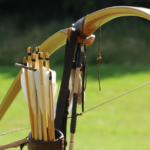Archery demands precision, focus, and control. While many archers concentrate on perfecting their stance, draw, and release, breathing is a crucial aspect that often gets overlooked.
Proper breathing techniques can significantly enhance archery performance, helping maintain stability, reduce anxiety, and improve overall accuracy.
This comprehensive guide explores the intricate world of archery breathing techniques and how they can elevate your game to new heights.
The Importance of Breath in Archery
At full draw, an archer’s body is under significant tension. Muscles are engaged, the mind is focused on the target, and heart rate may be elevated because of physical exertion and mental pressure.
Proper breathing helps regulate physiological state, reducing muscle tension, steadying aim, and enhancing mental clarity.
Breathing plays a vital role in oxygenating blood, which is crucial for maintaining steady muscle control and visual acuity.
By mastering breath control, archers fine-tune their body’s internal systems to work in harmony with their archery technique.
Diaphragmatic Breathing: The Foundation of Archery Breath Control
Diaphragmatic breathing, also known as belly breathing, forms the core of effective archery breathing. This technique involves breathing deeply into the diaphragm rather than shallowly into the chest.
To practice diaphragmatic breathing:
- Stand in your normal archery stance.
- Place one hand on your chest and the other on your belly.
- Inhale slowly through your nose, focusing on expanding your belly rather than your chest.
- Exhale slowly through your mouth, feeling your belly contract.
Regular practice of this technique, even when not shooting, will make it second nature, allowing you to maintain a steady respiratory rhythm during your shot cycle.
Integrating Breathing into Your Shot Cycle
Once you’ve mastered the basics of diaphragmatic breathing, it’s time to incorporate it into your shot cycle. Here’s a step-by-step guide:
- As you approach the shooting line, take a few deep, diaphragmatic breaths to center yourself.
- When you nock your arrow, take another deep breath.
- As you raise your bow and begin your draw, inhale slowly.
- At full draw, exhale about half of your breath and pause.
- Aim and release during this natural respiratory pause.
- Complete your exhale during the follow-through.
This rhythm allows you to be at your most stable point – the natural pause between exhale and inhale – when you release the arrow. During this moment, your body experiences the least amount of internal movement, providing optimal conditions for a precise shot.
Advanced Breathing Techniques for Archery
Once you’ve mastered the basics, explore more advanced breathing techniques to further enhance your performance:
Box Breathing
Box breathing, also known as square breathing, is a technique used by military personnel and athletes to maintain calm under pressure. Here’s how to do it:
- Inhale for a count of four.
- Hold your breath for a count of four.
- Exhale for a count of four.
- Hold your breath for a count of four.
- Repeat.
Practice this technique before you begin shooting to calm your nerves and center your focus.
The 4-7-8 Technique
This technique is particularly useful for managing pre-competition anxiety:
- Inhale quietly through your nose for 4 seconds.
- Hold your breath for 7 seconds.
- Exhale forcefully through your mouth, pursing the lips, for 8 seconds.
- Repeat the cycle up to 4 times.
Coherent Breathing
Coherent breathing involves synchronizing your breath with your heart rate, typically aiming for about 5 breaths per minute:
- Inhale for a count of 5-6 seconds.
- Exhale for a count of 5-6 seconds.
- Repeat.
This technique can help regulate your autonomic nervous system, promoting a state of calm alertness ideal for archery.
Overcoming Common Breathing Challenges in Archery
Even with practice, you might encounter some challenges when implementing these breathing techniques:
Holding breath too long
Some archers make the mistake of holding their breath for extended periods, leading to tension and instability. Remember, the goal is to shoot during a natural respiratory pause, not to hold your breath indefinitely.
Shallow breathing
Under pressure, it’s easy to revert to shallow, chest-based breathing. Regular practice of diaphragmatic breathing can help overcome this tendency.
Inconsistent rhythm
Your breathing rhythm should be consistent from shot to shot. Use a mental count or a physical cue (like the expansion of your belly) to maintain consistency.
Overbreathing
Breathing too deeply or rapidly can lead to lightheadedness. Focus on calm, controlled breaths.
Integrating Mindfulness and Visualization
Breathing techniques in archery aren’t just about physical control – they’re also a gateway to enhanced mental focus.
By focusing on your breath, you’re practicing a form of mindfulness that can help quiet the mind and improve concentration.
Try incorporating visualization into your breathing practice. As you breathe, imagine the perfect shot – the smooth draw, the steady aim, the clean release.
This mental rehearsal, combined with controlled breathing, can significantly enhance your performance when you step up to shoot.
Adapting Breathing Techniques to Different Archery Disciplines
While the core principles of archery breathing stay consistent, you may need to adapt your technique slightly depending on your discipline:
Target Archery
In the controlled environment of target archery, you have more time to establish a steady breathing rhythm. Focus on consistency from shot to shot.
Take advantage of the controlled setting to really hone your breathing technique.
Before each end, take a moment to center yourself with a few deep breaths. As you approach the shooting line, begin your breathing routine.
Maintain this rhythm throughout your shots, ensuring each arrow is released at the same point in your breath cycle.
Field Archery
The varied terrain and shooting positions in field archery may need more flexibility in your breathing technique. Practice your breathing in different stances and on uneven ground.
Field archery presents unique challenges, as you’ll often be shooting uphill, downhill, or in awkward positions.
Adapt your breathing to these situations by practicing in similar conditions during training. Learn to quickly establish your breath control regardless of your physical position.
3D Archery
The quick pace of 3D archery means you’ll need to establish your breathing rhythm quickly. Work on rapidly centering yourself with a few deep breaths before each shot.
In 3D archery, you often have limited time to prepare for your shot.
Develop a quick breathing routine that you can apply in just a few seconds. This might involve a single deep breath followed by a controlled exhale as you draw and release.
Olympic Recurve
The clicker used in Olympic recurve archery adds an extra element to consider. Sync your breathing with the clicker, aiming to release at the click during your natural respiratory pause.
The clicker introduces a precise timing element to your shot.
Practice coordinating your breath so that you reach your natural respiratory pause just as the clicker is about to engage. This synchronization can significantly improve your consistency and accuracy.
The Science Behind Archery Breathing
Understanding the physiological effects of proper breathing can help reinforce it’s importance:
Oxygen Intake
Proper breathing confirms optimal oxygen intake, crucial for muscle control and visual acuity. When you breathe deeply and efficiently, you’re providing your body with the oxygen it needs to function at it’s best.
This is particularly important in archery, where fine motor control and sharp vision are essential.
Heart Rate Regulation
Controlled breathing helps regulate heart rate, reducing the pulse’s impact on aim stability. A steady heart rate minimizes unwanted body movement, allowing for a more stable shot.
By controlling your breath, you’re effectively managing your heart rate, creating ideal conditions for accuracy.
Parasympathetic Response
Deep, slow breathing activates the parasympathetic nervous system, promoting a state of calm focus. This “rest and digest” state is ideal for archery, as it reduces anxiety and promotes clear thinking.
Regular practice of controlled breathing can help you quickly enter this state when you need it most, such as during competition.
Muscle Relaxation
Proper breathing techniques can help reduce unnecessary muscle tension, leading to a smoother draw and release.
When you breathe correctly, you’re encouraging your muscles to relax, which is crucial for maintaining proper form throughout your shot sequence.
Tense muscles can lead to inconsistent shots, so learning to relax through breath control is a valuable skill.
Exercises to Improve Your Archery Breathing
To master these techniques, regular practice is key. Here are some exercises to incorporate into your training:
Daily Diaphragmatic Breathing
Spend 5-10 minutes each day practicing diaphragmatic breathing, even when you’re not shooting. This can be done anywhere – while sitting at your desk, lying in bed, or standing in line at the grocery store.
The more you practice, the more natural it will become.
Breath Counting
While at full draw (without an arrow), count your breaths. Aim for consistency in the number of breaths you take before each simulated shot.
This exercise helps you develop a consistent rhythm and teaches you to be aware of your breathing pattern.
Breath Hold Training
Gradually increase the duration of your natural respiratory pause to improve stability during aim and release. Start with short holds and slowly work your way up.
Remember, the goal isn’t to hold your breath for as long as possible, but to find the optimal pause length for your shot sequence.
Breathing Under Pressure
Have a training partner create distractions or time pressure while you practice your breathing techniques. This could involve them making noise, setting time limits, or even engaging you in conversation as you prepare to shoot.
Learning to maintain your breathing technique under these conditions will help you stay focused during competitions.
Biofeedback Training
If possible, use biofeedback devices to watch your heart rate and breathing patterns, helping you fine-tune your technique. Many smartwatches and fitness trackers now offer this functionality.
By seeing real-time data on your physiological state, you can make immediate adjustments to your breathing to achieve optimal results.
Advanced Breathing Strategies for Competition
As you become more proficient with basic breathing techniques, you can start to apply more advanced strategies, especially useful in competitive situations:
Pre-Competition Breathing Routine
Develop a specific breathing routine to use before competitions. This might involve a combination of the techniques we’ve discussed, tailored to your personal preferences.
For example, you might start with box breathing to calm pre-competition nerves, then transition to coherent breathing as you approach the shooting line.
Having a set routine can help trigger a state of focused calm, regardless of the pressure of the situation.
Micro-Adjustments During Aiming
Learn to make tiny adjustments to your breath while at full draw. As you aim, you might notice that your sight picture isn’t perfectly stable.
Instead of letting down and starting over, try making small changes to your breath.
A slightly deeper exhale or a momentary pause can often be enough to steady your aim without disrupting your shot sequence.
Recovery Breathing
Develop a quick breathing technique to use between ends or after a bad shot. This can help you reset mentally and physically, preventing one poor shot from affecting the rest of your performance.
A simple technique like taking three deep, focused breaths can be enough to help you regain your composure and refocus.
Breath Awareness
Practice maintaining awareness of your breath throughout your entire shooting session, not just during the shot sequence. This constant awareness can help you stay centered and focused, even when you’re not actively shooting.
It can also help you identify when your breathing pattern is starting to change because of fatigue or stress, allowing you to make adjustments before it affects your shooting.
Breathing and Mental Game
The connection between breathing and the mental aspects of archery cannot be overstated. Proper breathing techniques can significantly enhance your mental game:
Stress Reduction
Controlled breathing is a powerful tool for managing stress and anxiety. In high-pressure situations, your breath can be an anchor, helping you stay calm and focused. When you feel nerves creeping in, return your attention to your breath.
This simple act can help ground you in the present moment and reduce anxiety.
Focus Enhancement
Focusing on your breath can help quiet the mind, reducing distracting thoughts. This is particularly useful when you find your mind wandering during a competition.
By bringing your attention back to your breath, you’re effectively resetting your focus.
Confidence Building
As you become more proficient with your breathing techniques, you’ll likely notice an increase in your overall confidence. Knowing that you have a reliable method to control your physiological state can be incredibly empowering.
This confidence can translate directly into improved performance on the range.
Rhythm and Timing
Your breath can serve as a natural metronome for your shot sequence. By syncing your actions (drawing, aiming, releasing) with specific points in your breath cycle, you can develop a consistent rhythm.
This can lead to improved timing and more consistent shooting.
Breathing and Physical Conditioning
While we’ve primarily focused on breathing techniques for shooting, it’s worth noting that proper breathing can also enhance your overall physical conditioning for archery:
Endurance Training
Incorporating breath control into your physical training can help improve your endurance. This is particularly important for field and 3D archers who may need to maintain performance over long periods or in challenging terrain.
Strength Training
Proper breathing is crucial during strength training exercises. Learning to breathe correctly during workouts can help you develop the core and upper body strength needed for archery while reducing the risk of injury.
Flexibility and Mobility
Many archers overlook the importance of flexibility and mobility. Incorporating breathing exercises into stretching routines can help improve flexibility, particularly in the shoulders and upper back – areas crucial for maintaining proper form in archery.
Breathing and Equipment Setup
Your breathing technique can even influence your equipment choices and setup:
Draw Weight
Your ability to control your breath at full draw should be a factor in determining your ideal draw weight. If you’re struggling to maintain steady breathing with your current draw weight, it might be too heavy.
Stabilizer Setup
The rhythm and depth of your breathing can affect how your stabilizers perform. Experiment with different stabilizer configurations while paying close attention to your breathing to find the optimal setup.
Release Aid Adjustment
For compound archers using a release aid, the timing of your release should be coordinated with your breathing. Adjust your release aid tension or travel to match your optimal release point in your breath cycle.
Adapting Breathing Techniques to Different Weather Conditions
Weather can significantly impact your shooting, and adapting your breathing techniques to different conditions can help maintain consistency:
Cold Weather
In cold conditions, your breath is visible, which can be distracting. Practice shooting in cold weather to get used to seeing your breath.
Additionally, cold air can make breathing more difficult, so focus on taking slightly deeper breaths to ensure adequate oxygen intake.
Hot Weather
Heat can lead to rapid breathing and increased heart rate. In hot conditions, focus on keeping your breathing slow and controlled. You might need to take slightly shorter breaths to avoid hyperventilation.
Wind
Windy conditions can be particularly challenging for breathing techniques. The sound and feel of the wind can be distracting, and it can also affect your balance.
Practice maintaining your breathing rhythm even when gusts of wind are trying to throw you off.
High Altitude
If you’re shooting at high altitude, you’ll need to adapt to the thinner air. Focus on taking deeper, more deliberate breaths to ensure you’re getting enough oxygen.
Long-Term Benefits of Mastering Archery Breathing
Developing strong breathing techniques in archery can have benefits that extend beyond the sport:
Stress Management
The breathing techniques you learn for archery can be applied to manage stress in everyday life. Whether you’re facing a challenging work situation or a personal crisis, your archery breathing skills can help you stay calm and focused.
Improved Overall Health
Regular practice of deep, controlled breathing can have many health benefits, including lower blood pressure, reduced anxiety, and improved digestion.
Enhanced Body Awareness
As you become more attuned to your breath, you’ll likely develop a greater overall awareness of your body. This can be useful in other sports and physical activities.
Mental Discipline
The focus and discipline required to master breathing techniques can translate into other areas of life, improving your ability to concentrate and stay calm under pressure.
Common Myths About Archery Breathing
There are several misconceptions about breathing in archery that are worth addressing:
Myth: You should always hold your breath when shooting
Reality: While there is a brief pause in breathing during the shot, holding your breath for extended periods can increase tension and instability.
Myth: Breathing techniques are only important for elite archers
Reality: Proper breathing can benefit archers at all levels, from beginners to professionals.
Myth: There’s one “correct” way to breathe in archery
Reality: While there are general principles, the specifics of breathing techniques can vary based on person physiology and shooting style.
Myth: Breathing techniques are only important during the actual shot
Reality: Proper breathing is crucial throughout your practice and competition, not just during the moment of release.
Integrating Technology into Breathing Practice
Modern technology can be a valuable tool in developing and refining your breathing techniques:
Breathing Apps
There are many smartphone apps designed to guide you through various breathing exercises. These can be particularly useful when practicing away from the range.
Heart Rate Variability (HRV) Monitors
HRV watches can provide insights into how your breathing affects your nervous system. This data can help you refine your techniques for optimal performance.
Slow-Motion Video Analysis
Using slow-motion video to analyze your shooting can help you see how your breathing affects your form and shot execution.
Virtual Reality (VR) Training
Some advanced training systems use VR to simulate competition environments. These can be excellent for practicing your breathing techniques under pressure.
The Role of Nutrition in Breathing and Performance
What you eat and drink can affect your breathing and overall archery performance:
Hydration
Proper hydration is crucial for maintaining steady breathing. Dehydration can lead to rapid, shallow breathing, which can negatively impact your shooting.
Caffeine
While caffeine can enhance alertness, it can also increase heart rate and potentially disrupt your breathing rhythm. Be aware of how caffeine affects you personally.
Meal Timing
Eating too close to shooting time can affect your breathing as your body diverts energy to digestion. Experiment with meal timing to find what works best for you.
Foods that Support Lung Function
Certain foods, such as those rich in antioxidants and omega-3 fatty acids, can support lung health and potentially improve your breathing capacity.
Breathing Techniques for Archery Instruction
If you’re an archery instructor, incorporating breathing techniques into your teaching can greatly benefit your students:
Starting Early
Introduce basic breathing awareness to beginners from their very first lessons. This sets a foundation for good habits as they progress.
Visual Aids
Use diagrams or animations to help students understand the mechanics of diaphragmatic breathing.
Group Breathing Exercises
Incorporate group breathing exercises into your classes. This can help students feel more comfortable practicing these techniques.
Individual Coaching
Pay attention to each student’s breathing patterns and offer personalized advice on how they can improve.
The Future of Breathing Techniques in Archery
As our understanding of human physiology and sports science continues to advance, we can expect to see further developments in archery breathing techniques:
Personalized Breathing Profiles
Advanced biometric testing may allow archers to develop highly personalized breathing strategies based on their unique physiology.
Integration with AI Coaching
Artificial intelligence could potentially analyze an archer’s breathing patterns in real-time, offering immediate feedback and suggestions for improvement.
Cross-Disciplinary Insights
We may see more influence from other disciplines such as yoga, meditation, and high-performance athletics, bringing new perspectives to archery breathing techniques.
People Also Asked
How does breathing affect archery accuracy?
Proper breathing in archery helps stabilize the body, reduce muscle tension, and improve focus, all of which contribute to better accuracy.
Controlled breathing can also help regulate heart rate, minimizing unwanted body movement during the shot.
What is the best breathing technique for archery?
While person preferences may vary, many archers find success with diaphragmatic breathing. This involves breathing deeply into the belly rather than the chest.
The key is to establish a consistent rhythm and release the arrow during the natural pause after exhaling.
How do Olympic archers breathe?
Olympic archers typically use a combination of diaphragmatic breathing and timed breathing techniques. They often synchronize their breath with their shot sequence, aiming to release the arrow during the natural pause after exhaling.
Can breathing exercises improve my archery performance?
Yes, regular practice of breathing exercises can significantly improve archery performance. These exercises help develop better breath control, reduce anxiety, and enhance focus, all of which contribute to more consistent and accurate shooting.
How long should I hold my breath when shooting a bow?
You shouldn’t hold your breath for an extended period when shooting. Instead, aim to release the arrow during the natural pause after exhaling.
This pause typically lasts 2-3 seconds, which is usually enough time to execute the shot.
Does altitude affect breathing in archery?
Yes, higher altitudes can affect breathing because of the thinner air. Archers shooting at high altitudes may need to adjust their breathing techniques, typically by taking deeper, more deliberate breaths to ensure adequate oxygen intake.
How can I calm my nerves before an archery competition?
Practicing calming breathing techniques like box breathing or the 4-7-8 technique can help reduce pre-competition nerves.
Establishing a consistent pre-shot breathing routine can also help center your focus and calm your nerves.
Is it better to inhale or exhale when releasing an arrow?
Most archers prefer to release the arrow during the natural pause after exhaling. This moment tends to be when the body is most stable.
However, some archers may prefer to release while slowly exhaling.
The key is consistency in your chosen method.
How does wind affect breathing in archery?
Wind can be distracting and affect an archer’s balance, potentially disrupting normal breathing patterns. It’s important to practice maintaining your breathing rhythm even in windy conditions.
Some archers find it helpful to time their shots between gusts.
Can improper breathing cause target panic in archery?
While improper breathing isn’t typically the sole cause of target panic, it can contribute to the problem. Inconsistent or shallow breathing can increase tension and anxiety, which are often factors in target panic.
Learning proper breathing techniques can be part of overcoming this issue.
Key Takeaways
- Diaphragmatic breathing forms the foundation of effective archery breathing techniques.
- Integrate your breathing into your shot cycle, aiming to release during the natural pause after exhaling.
- Advanced techniques like box breathing and coherent breathing can further enhance your performance.
- Adapt your breathing techniques to different archery disciplines and shooting conditions.
- Regular practice and mindfulness can help make proper breathing an automatic part of your archery routine.
- Understanding the science behind breathing techniques can reinforce their importance and encourage consistent practice.
- Specific exercises can help you refine your breathing skills and apply them effectively in competition settings.



